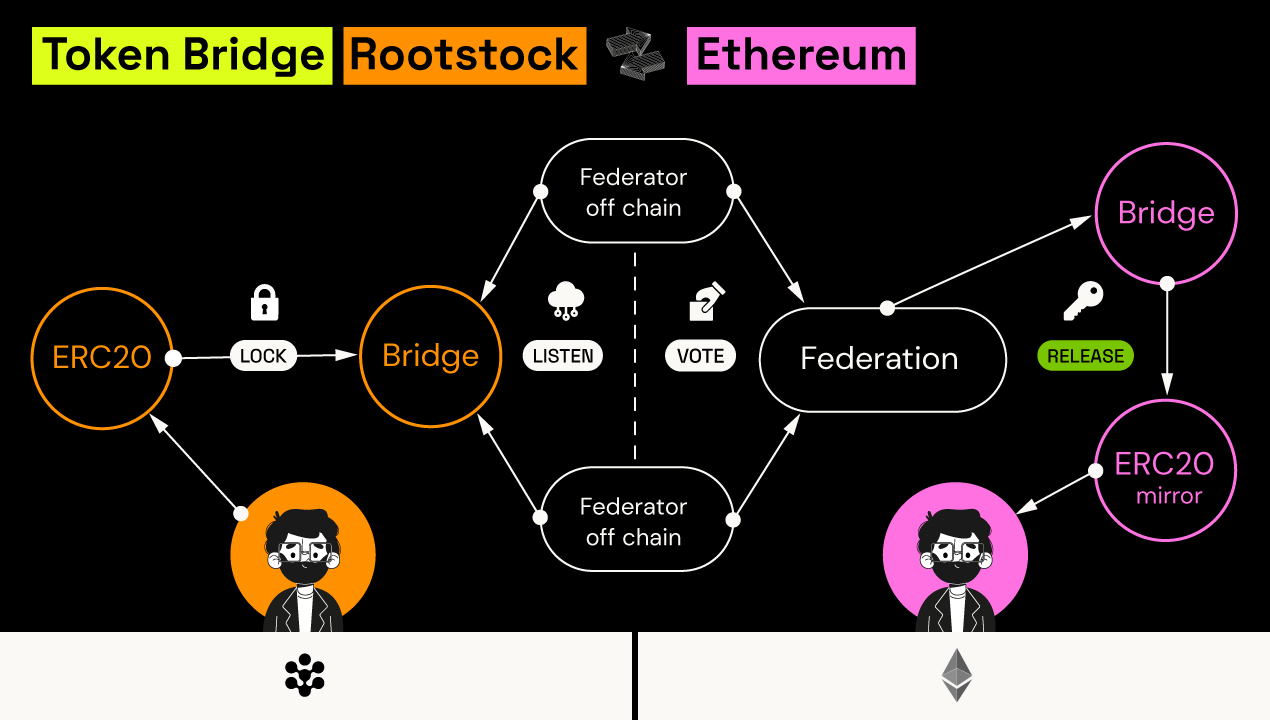Time to read: 1 min
Token Bridge FAQs
Find a list of frequently asked questions about the Token Bridge.
- The Token Bridge is an interoperability protocol which allows users to move their own Rootstock or Ethereum ERC20 Tokens between networks in a quick and cost-efficient manner.
- The UI is available at:
- Side Token is an ERC777 representation of a ERC20 compatible tokens which is on another network (could be on Ethereum or Rootstock network). The Side Token displays the exact same properties as the standard ERC20 token and allows it to be used in all the same places as ERC20.
- Side Tokens are minted to prove cross chain bridges can work in a safe and secure manner with 2 standalone blockchains. We believe this kind of interoperability technology offers a lot of possibilities for smart contract owners, as they may prefer to do certain operations in one chain, and others in another one. By connecting blockchains with these bridges you allow for a variety of new use cases that never existed before.
- No! It’s important to note that there will be no increase in the original tokens. The existing amount of circulating original tokens will stay the same and simply be distributed across 2 networks (Rootstock Network & Ethereum network) instead of 1.
- The original token lives on the network that it was deployed for example Ethereum, while the Side Token is a representation of the original token on the other network, for example Rootstock.
- The symbol of the Side Token is the original token symbol with an
rprefix if it is created in Rootstock or aneprefix if it is created in Ethereum. For example, if we cross theRIFtoken from Rootstock to Ethereum, the Side Token symbol would beeRIF. - The number of decimal places will be 18. These are the 'addresses' of the deployed contracts in the different networks.
- The Token Bridge will be a public dApp where users will be able to access by using Liquality Wallet or Metamask. You will be able to send your original tokens and receive an equivalent amount of Side Tokens on the other network. By toggling the network on Metamask, you’re also able to transfer the other way around, by sending Side Tokens and receive original tokens.
- Upon receiving your Side Tokens, you no longer own your original tokens. The moment you use the bridge to send them to the other network (Rootstock or Ethereum), they are locked up and stored in the contract address. Thus you effectively have no original tokens on the original network and now have Side Tokens on the other network.
- There is no limit on the total. Hypothetically, the entire circulating supply can be bridged, though this is unlikely happen as there will be strong use cases to use the tokens on either network.
- However, there is a minimum and maximum amount per transaction and daily quotas. You can see them on https://dapp.tokenbridge.rootstock.io/
- Only whitelisted tokens can cross the bridge, this curated list is used to avoid malicious contracts and DDoS attacks.
- There is a 0.2% fee charge when crossing the tokens, this fee goes to the validators as payment for crossing the transactions.
- Confirmations depends on the amount being crossed:
- Small amounts needs 60 confirmations on the Rootstock Mainnet, and 120 confirmations on the Ethereum Mainnet.
- Medium amounts needs 120 confirmations on the Rootstock Mainnet, and 240 confirmations on the Ethereum Mainnet.
- Large amounts needs 2880 confirmations on the Rootstock Mainnet, and 5760 confirmations on the Ethereum Mainnet.
-
Note that the values of small, medium, and large amount are defined per token basis, and may change over time.
-
You can see these amounts defined in the Token List.
- The Token Bridge functionality is quite unique, yet simple to understand. The ratio of tokens during network transfer always remains 1:1 and behaves in the following manner:
- When original tokens are moved to the other network
- Original tokens are locked in the Token Bridge smart contract
- Side Tokens are minted and assigned to the same address that originally called the bridge
- When Side Tokens are moved back from the other network
- Side Tokens are burned
- Original tokens are unlocked in the Token Bridge smart contract, and transferred to the same address that originally called the bridge contract.
- When original tokens are moved to the other network
